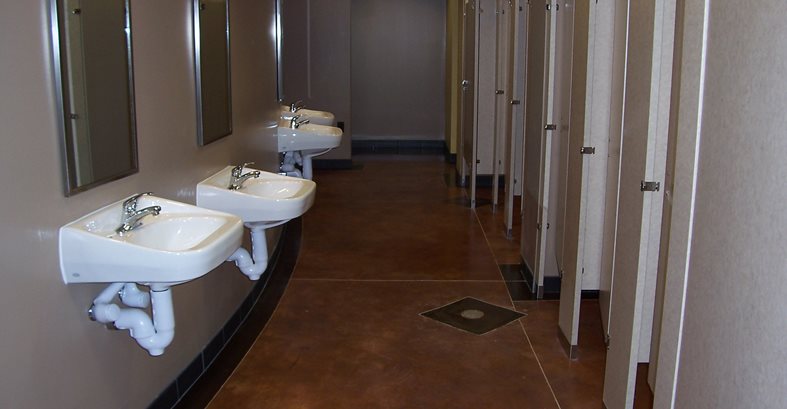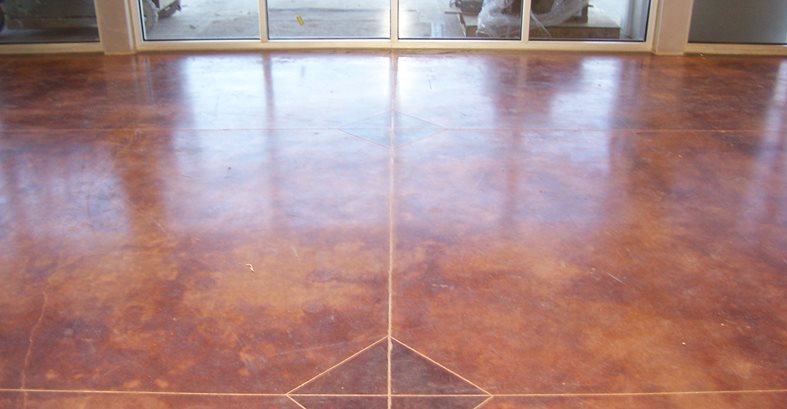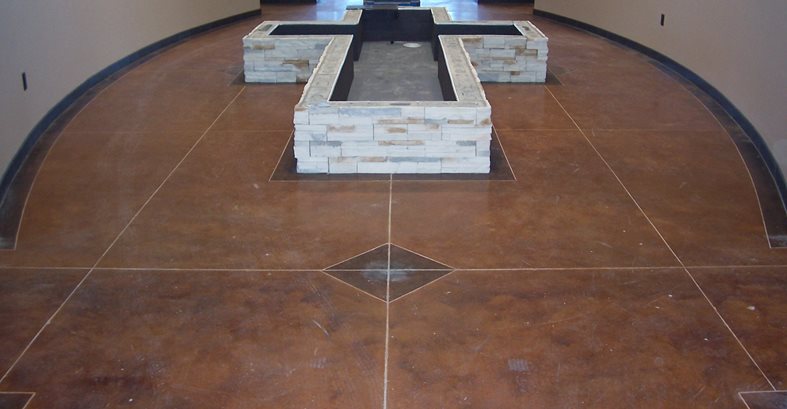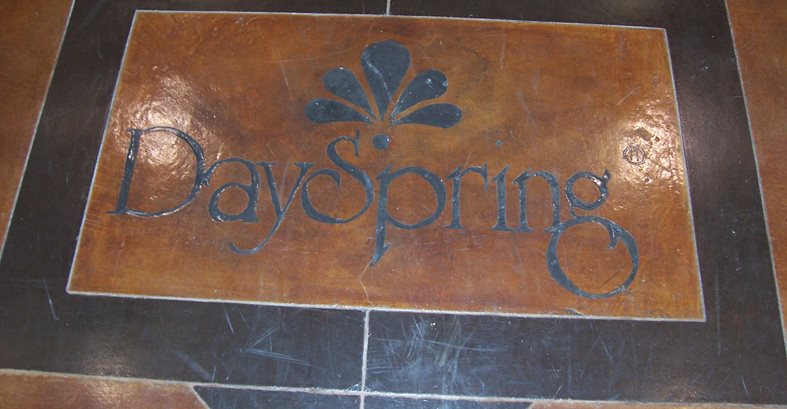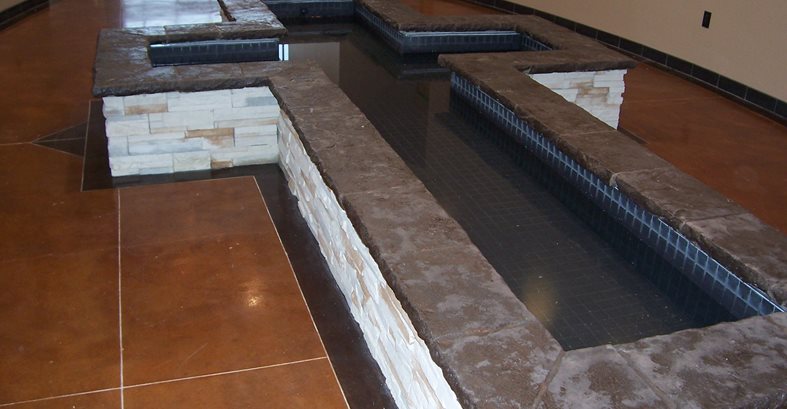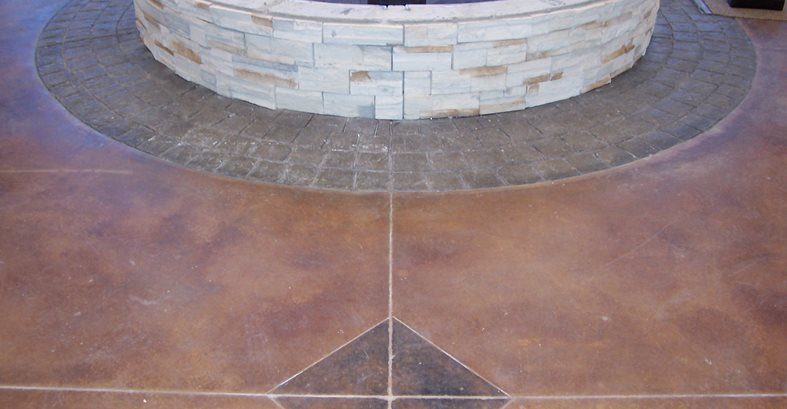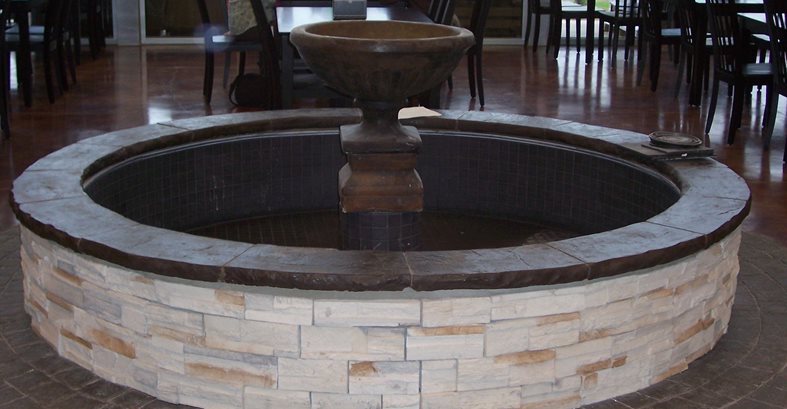With a solid reputation for three generations, it's no wonder clients flock to Solid Rock Concrete in Gravette, Ark. when they need decorative concrete work. Owner Shane Ober says the company specializes in concrete driveways and patios. They also enjoy doing concrete countertops and vertical concrete applications, but their real talent lies in concrete overlays.
Recently, they resurfaced a 4,700 square foot interior floor with concrete stains and saw cut patterns. "We did the entrance hall, all the bathrooms, the main foyer, and the kitchen area of the headquarters for Day Spring greeting card company," says Ober. The job incorporated concrete stains and dyes, an engraved logo and sawcut diamond pattern, and a concrete cap for the edge of a fountain.
Interior Floors
The floor's design included large fields of warm brown/red concrete color with darker diamond shapes at intersecting lines. Working with the client's designer, Ober first needed to determine how to layout the saw cuts in the designer's diamond pattern tiles to coincide with the floor's expansion joints. "We try to incorporate in the design where the American Concrete Institute (ACI) recommends you sawcut in a slab," says Ober. "We try to incorporate that with the designs as far as if we're doing diamonds or a tile at a 45-degree angle." In order to get the Day Spring project to line up, Ober had to lay it out off of the expansion joints, putting in the diamonds specified by the designer.
Once the pattern was saw cut, Ober could begin coloring the floor. "Overall, the floor was in pretty good shape," he says. "We didn't really have to do anything else to it besides the cleaning and the prepping to receive the stain." To begin, Ober grouted everything with an oyster-white grout "to keep anything from going down underneath the cracks," he explains. Ober used Kemiko's 50/50 stain Brick Red with Amerpolishes' Dye & Seal Caramel color. "Then we came back over the floor to do some highlighting and some veining with a deep caramel," he explains. He also used a 50/50 black Kemiko stain for parts of the floor design. "We applied the color with an HVLP sprayer, and brushed it back in so it looks really neat," says Ober. "To get the variegated look, we use construction paper on it to create a vein, then come back in and use the HVLP sprayer. Then we put down another color."
Overall, Ober says they applied two coats of Kemiko 50/50 stain. Then came back over with the dye and seal. The next two coats were of an acrylic-based sealer, then two coats of an industrial floor coating wax to keep the floor maintainable. "We make our own sealer," explains Ober. "We buy a sealer from a chemical manufacturer, which is a 51% solids, cut that to 25%, then use a Johnson industrial type of wax."
Concrete Logo
To create the Day Spring logo in the concrete floor, Ober engraved it using Engrave-a-Crete tools. "We cut the logo out of a piece of plywood from their stencil. Then we engraved it and used Miracote in a regular, natural color, over the entire logo to make the spots that were engraved smoother so it would take the stain better."
Fountain Wall Caps
Ober also built the wall caps that went on top of the fountains. The vertical portion of the fountains is veneer stone. "Originally, the clients were going to cap them with natural rock," recalls Ober. "Then they saw one of our countertops we did with the split-faced granite edge, so they said they wanted that to match some of the darker diamond spots in the floor we cut. But they still wanted that white to match all of the grout joints that we put down too."
To create the caps, Ober poured them in his shop. The cross-shaped fountain measured 22-feet long and 12-feet wide at its biggest point. The round one was more difficult because of the irregular shapes of the veneer stone. "We did a radius circle and took the measurements to our shop," he says. The diameter measured a 12-foot circle. Using Fossilcrete's split-faced granite countertop forms, Ober cut the radius into 16 pieces. "When we installed them, they were only ¼-inch off in alignment. They were pretty much perfect," he says. After they went back over the cap and grouted everything on the stone, it filled the small gap perfectly. Kemiko's 50/50 black stain was the color used for the cap to match the floor accents.
Installation Challenges
One of the biggest challenges Ober faced was installing the job in the middle of winter. "We were trying to get everything to dry and still meet schedule," he says. It was also difficult to coordinate with the trades. "It was a high-pace job, we had to make sure everyone was on the same page with the carpet and tile guys. If we had something down or wet, no one could walk across it till it was dry." To accommodate, Ober ended up doing some work in the evenings or after hours, such as when they had to seal and wax.
About Solid Rock Concrete
Ober comes from a line of successful concrete contractors. "My grandfather did it his whole life, and my dad," he says. Ober continued the tradition and started Solid Rock Concrete in Arkansas 15 years ago. He says, "I wanted to make an impression in the decorative concrete market in the state of Arkansas." Ober attributes much of the success of the business to its solid foundation. The company name reflects this belief. "We wanted something that tied into concrete and what we believed in. Solid Rock Concrete came from the Bible, Psalm 40:2. We named our company after that."
As the verse states, 'He brought me up out of the pit of destruction, out of the miry clay, and He set my feet upon a rock making my footsteps firm' (Psalm 40:2), Solid Rock Concrete has endured the generations and continues to steadily build and create decorative concrete throughout Arkansas.
Solid Rock Concrete Services
Shane Ober
15625 Gaddy Ln
Gravette, AR 72736
(479) 254-9333
jewel2076@sbcglobal.net
Get inspiring ideas for church floors
